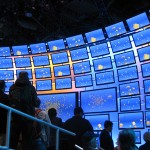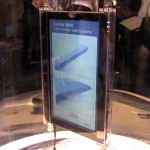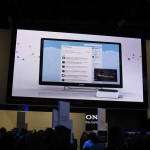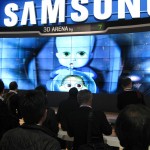 From the looks of CES 2011 it seems the economy is getting better, or at least people are optimistic about it. The Las Vegas Convention Center was, as usual, delightfully overwhelming. 3D televisions were everywhere to be found, and this year there were quite a few more manufacturers and distributors getting in on the 3D action, a contrast from last year’s convention where really only a few big guys like Panasonic and Samsung were displaying their 3D technology.
From the looks of CES 2011 it seems the economy is getting better, or at least people are optimistic about it. The Las Vegas Convention Center was, as usual, delightfully overwhelming. 3D televisions were everywhere to be found, and this year there were quite a few more manufacturers and distributors getting in on the 3D action, a contrast from last year’s convention where really only a few big guys like Panasonic and Samsung were displaying their 3D technology.
The biggest 3D showings came from Sony, Samsung, and Panasonic where crowds of attendees stared through 3D glasses at super huge grids of 3D displays. If you had any thoughts that electronics companies were giving up on 3D technology you would be wrong, at least this year.
LG’s 3D presentation and entire booth was quite impressive. As everyone walked in they were given a pair of Cinema3D glasses to use. But these “Passive” glasses – most likened to the RealD Cinema glasses used in theaters, are almost throwaways at $10 a pair. They are also light, sort of stylish, and flexible. Compare those to the heavy, cumbersome, and sometimes battery-operated 3D eyewear (which can be more likened to goggles) used by Panasonic and others and you figure LG might be on to something. LG also boasts their Cinema3D glasses work for every LG 3D television. And they weren’t lying. As you walked around their booth you were able to see 3D everywhere (albeit 540 lines per eye). Cheers, LG.
 But while 3D was a hot item, tablet interest was also sizzling. Lines piled up around the newest tablets from Toshiba, Panasonic, Sharp and others. What was sort of confusing was that some of the tablets, sized 4″ wide, looked more like mobile phones or iTouches rather than tablets. But heck, no-one has really defined what the size requirements are for a tablet so why complain? Well, if you look at the Apple iPad which really started this whole tablet thing one of the selling points is that it fills the gap between a laptop (which might be heavy to lug around) and a phone (which, let’s face it is too small to watch movies and look at photos on). Can everyone agree that a tablet should be at least 8″ wide?
But while 3D was a hot item, tablet interest was also sizzling. Lines piled up around the newest tablets from Toshiba, Panasonic, Sharp and others. What was sort of confusing was that some of the tablets, sized 4″ wide, looked more like mobile phones or iTouches rather than tablets. But heck, no-one has really defined what the size requirements are for a tablet so why complain? Well, if you look at the Apple iPad which really started this whole tablet thing one of the selling points is that it fills the gap between a laptop (which might be heavy to lug around) and a phone (which, let’s face it is too small to watch movies and look at photos on). Can everyone agree that a tablet should be at least 8″ wide?
Internet connectivity via televisions was also a major focus at CES. You can check your Facebook page, Tweet, and watch YouTube movies without moving from your television set. All the electronics companies were pushing integration, as if you can’t have more than one device in your house. According to a spokesperson, all this Internet connectivity is designed to “make your life easier and more enjoyable.” My theory is, like apps, every device can perform certain functions. You know how many times I’ve checked my Facebook page on my Samsung HDTV? Just the one time I set it up.
But obviously Sony and Google are not listening to me. Sony TVs with Google TV integration was given a big chunk of real estate in the Central Hall, where Sony dominated the entire wing. You couldn’t miss a giant Gulliver-sized tablet promoting Sony Internet TV powered by Google TV hanging from above. Sony started shipping Google TV-enabled TVs back in Oct. 2010, and the Google TV box sells for $399 at places like BestBuy and Amazon. To get Google TV, you need either one. The technology & software allows nice integration of live and recorded TV into your web browser. The picture-in-picture mode which puts your TV feed into a smaller window looks really nice, and you can also view your DVR and guide. Although, the PIP will not work in reverse (putting your Internet into the smaller window). There are plenty of apps to choose from including Napster, Netflix, and NBA Game Time. And, Sony reps said Google TV will also soon support Android.
Video wall technology was also on display at CES. Companies showed ultra thin monitors that can split into multiple screens or show one big image at the same time all at the touch of a remote. LG, Sony, Panasonic and Sharp had impressive displays that you couldn’t take your eyes off. Sharp showcased their i3 Wall featuring “Information Intelligent Imaging” that was so hot it felt more like a tanning booth than a video wall. Come to think of it…does anyone have any idea how many megawatts of electricity CES requires?














